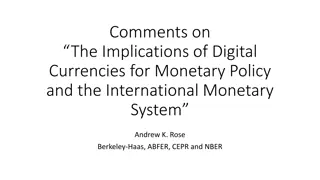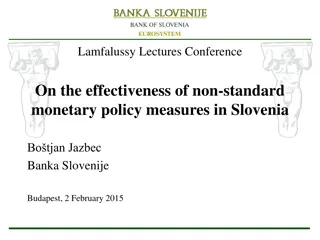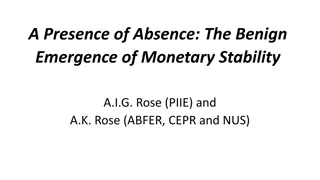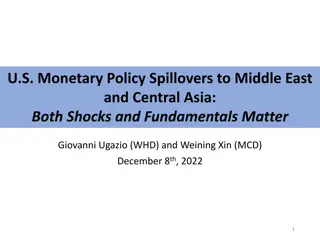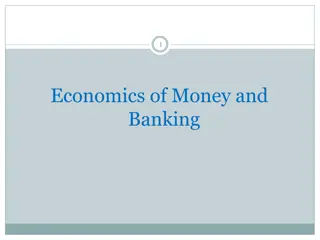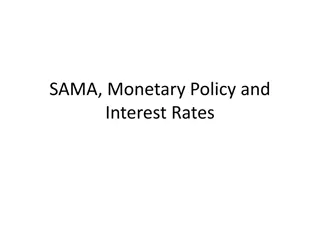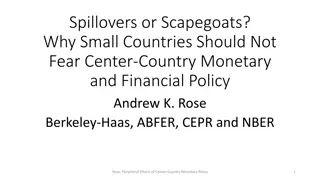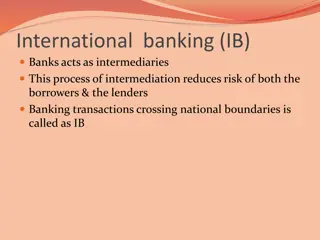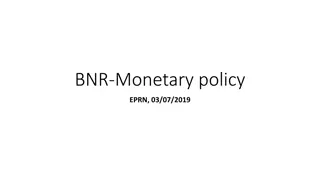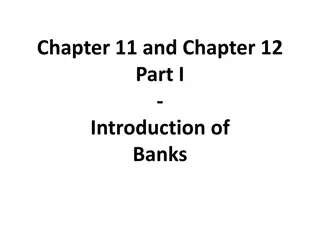Globalisation's Impact on Monetary Policy and Central Banking Paradigm
Globalisation has reshaped monetary policy dynamics, influencing inflation pressures and the transmission of shocks across economies. Unconventional monetary policies in small open economies have challenged conventional theories, highlighting the complexity of managing monetary conditions. The interplay between globalisation, productivity gains, and financial integration presents new considerations for central banks in navigating economic stability.
Download Presentation

Please find below an Image/Link to download the presentation.
The content on the website is provided AS IS for your information and personal use only. It may not be sold, licensed, or shared on other websites without obtaining consent from the author. Download presentation by click this link. If you encounter any issues during the download, it is possible that the publisher has removed the file from their server.
E N D
Presentation Transcript
Outline Does globalisation affect monetary policy? Unconventional monetary policy (UMP) small open economy perspective What do we know about deflation? A few thoughts on the new central banking paradigm
How much does increasing globalisation affect monetary policy? Global economy has become increasingly interconnected Evidence of a global financial cycle? (H. Rey) Global pool of liquidity through interconnected financial sector leads to monetary policy spill-overs Avenues for shock propagation and amplification are more open than ever before in CEE also thru banking system integration Financial fragility leakages To what extent has globalisation moderated inflation pressures? 2
Great moderation of inflation? Globalization and increased trade integration have reduced barriers to market access Globalization has led to the relocation of production the relative price of tradable goods declines their fall has contributed to lower overall inflation More intense global competition prevents firms from raising prices and puts downward pressures on wages in many sectors; Broad productivity gains, or Cyclical conditions? 3
Last 15 years have seen broad productivity gains in EM Source: The Conference Board. 4
..monetary conditions are becoming more influenced by non-dometic factors.. Globalization may have reduced the strength of the cyclical response of inflation to output fluctuations prices of many items that are produced or consumed at home are increasingly determined by foreign demand and supply factors rather than local factors. financial integration allows for larger trade balance deficits or surpluses and, thereby, weakens the relationship between domestic output and demand International capital flows transmit monetary conditions globally, even under floating exchange-rate regimes More of an issue for small open economies, than for a few big ones 5
UMP Small Open Economy Perspective Is it possible to run countercyclical monetary policy in a small open economy with stable exchange rate regime? According to conventional wisdom NO! But, in real life YES financial market imperfections limit perfect capital mobility, so can CBs, behaviour of economic agents is path dependent... central banks can widen their space for maneuver with the use of unconventional monetary policy and/or macroprudential measures What have we learned from the crisis It is absolutely critical to act in time It is impossible to make-up for a delay, but better to act at any time than not to act at all In order to act in time, one should often try to think out of the box (reading from history helps)
(Unconventional) Monetary Policy - pre-crisis - Bank (regulatory) capital adequacy ratio (CAR) U(M)P in the pre-crisis period CNB one of those central banks that acted early to take care about financial stability and external vulnerabilities build-up 22 20 18 16 % use of UMP and macroprudential measures to fight against excessive capital inflows (capital inflow tax, high fx liquidity requirements,tax on credit growth, increasing risk-weights for lending to unhedged borrowers...) 14 12 10 2008 2009 2010 2011 2012 2013* Croatia Eurozone CEE Regulatory capital and international reserves success in moderating banks credit growth success in curbing banks foreign indebtness creation of sizeable f/x liquidity buffers doubling of banks Tier 1 capital 60,0 12,000 50,0 10,000 40,0 8,000 bln HRK mioEUR 30,0 6,000 significant, although limited, impact on curbing overall external vulnerabilities 20,0 4,000 10,0 2,000 0,0 0,000 XII.2001 XII.2002 XII.2003 XII.2004 XII.2005 XII.2006 XII.2007 XII.2008 XII.2009 Regulatory capital International reserves (rhs) Net usable international reserves (rhs) Source: HNB
(Unconventional) Monetary Policy - post crisis - Reserve requirements and minimum f/c liquidity U(M)P in the post-crisis period At the strike of the crisis, critical objectives were: 60 50 40 % to preserve confidence (exchange rate stability) 30 to facilitate refinancing of all domestic sectors, since foreign markets were effectively temporary closed (LOLR) huge relaxation of domestic currency and f/x liquidity (approx. 13 percent of GDP) possible thanks to the pre-crisis creation of buffers 20 10 0 2004 2005 2006 2007 2008 2009 2010 2011 2012 2013 2014 Reserve requirement Marginal reserve requirement Minimum foreign currency liquidity Source: HNB Liquidity surplus and overnight interest rate 20 After initial strike, objective turned to facilitate credit activity creation of structural excess liquidity corporate lending programs to banks syndicated with HBOR 2010-14 (the early Croatian version of Funding for Lending) 18 8 16 14 6 billion HRK 12 % 10 4 8 6 2 4 2 0 0 1/06 7/06 1/07 7/07 1/08 7/08 1/09 7/09 1/10 7/10 1/11 7/11 1/12 7/12 1/13 7/13 1/14 incorporates risk sharing element corporate lending programme to banks without HBOR from November-2013 Liquidity surplus (including overnight deposits with the HNB) -right Overnight interbank interest rate -left 1-year T-bills (HRK) -left Source: HNB
Pre and post crisis Banks' credit to private sector 50,0 Marginal reserve requirements HNB's Compulsory treasury bills New decision on capital adequacy HNB lending programmes (incl. HBOR) 40,0 HNB's Compulsory treasury bills 30,0 HNB lending programme (excl.HBOR) 20,0 10,0 0,0 XII.2001 XII.2002 XII.2003 XII.2004 XII.2005 XII.2006 XII.2007 XII.2008 XII.2009 XII.2010 XII.2011 XII.2012 XII.2013 -10,0 Banks' credit to private sector, % growth Banks' credit to enterprises, % growth Banks' credit to households, % growth Source: HNB
Countercyclical monetary policy post crisis - high(est) cumulative growth of corporate lending... Changes of loans to enterprises, in % (8/2008 3/2014) 40 Change of loans to enterprises, in % (8/2008-3/2014) 25,8 30 20,5 19,819,1 20 12,111,2 10 5,2 3,2 3,1 0 -0,3 -1,8 -2,4-3,4 -4,7 -10 -5,5 -12,8 -14,7 -20 -30 -26,1 -29,4 -30,9-31,9 -40 -36,0 -50 -54,5 -60 FIN SWE GBR IRL NLD AUT DEU BEL FRA CRO ITA GRC PRT ESP SVK POL CZE SVN HUN EST LTU BGR ROM EU 15 south continental EU 15 north EU 15 EU 12 south EU 12 EU 12 north continental Note: EU15 = Finland, Ireland, Sweden and United Kingdom (north), Austria, Belgium, France, Germany and Netherlands, (continental), Greeece, Italy, Portugal and Spain (south). EU 12 = Estonia, Latvia(north) Czech Republic, Hungary, Poland, Slovakia and Slovenia(continental), Bulgaria and Romania (south) Source: ECB and national central banks 10
...and the second strongest GDP decline Real gross domestic product, (GDP change, average 2009-2013) 3 2,7 Real GDP, 2009 - 2013, % change 2 1,4 1,0 0,7 1 0,6 0,4 0,3 0,2 0 0,0 -0,1 -0,3 -0,4 -0,4 -1 -0,6 -0,7 -0,9 -0,9 -0,9 -1,1 -1,3 -1,4 -1,5 -2 -1,9 -2,5 -3 -4 -5 -5,2 -6 IRL FIN DNK GBR SWE NLD FRA BEL AUT DEU GRC CRO ITA PRT EU15 south ESP SVN HUN CZE SVK POL LVA LTU EST BGR ROM EU12 continental EU12 south EU12 north EU15 north EU15 continental Note : EU15 = Denmark, Finland, Ireland, Sweden and United Kingdom (north), Austria, Belgium, France, Germany and Netherlands, (continental), Greece, Italy, Portugal and Spain (south). EU 12 = Estonija, Lithuania, Latvia (north), Czech Republic, Hungary, Poland, Slovakia and Slovenia(continental), Bulgaria and Romania (south) Source:Eurostat 11
Broadening of Central Banks Mandate Lessons Based on CNB s Pre-Crisis Experience Taking care about financial stability and external vulnerabilities hardly possible to make clear separation among policy instruments in relation to goals synergy among various policy tools (monetary / macroprudential / microprudential) banks supervision at the central bank helps before the crisis CNB was heavily criticized for its measures intrinsic problem financial stability is difficult to measure, but crises are evident without crises defending unpopular measures may become increasingly difficult in a way the global financial crisis helped CNB to prove its success on financial stability front important to resist pressures and stick to long-term policy goals however, neither monetary nor macroprudential policy can resolve key problems CNB s success in reducing external vulnerabilities was limited only if all policies (fiscal, institutional, structural) play together it will be possible to create sustainable growth CNB s success on financial stability front and in countercyclical monetary policy made other policy makers more lenient to push forward strong structural and fiscal reforms after the strike of the crisis
...current issue - CNBs main objective is mainly externaly driven.. Inflation decomposition into baseline projection and domestic and external shocks in a small open economy (Croatia) Strong negative external shocks of prices of food raw materials and oil are primary causes of recent low inflation rates Unfavourable trends in the external real sector and domestic negative GDP gap contribute to deflationary pressures to a much smaller extent 13
What do we know about deflation in Croatia? Deflation pressure is coming from a fall of food and energy prices If the food and energy prices were at their five year average (2008-2013), inflation would have been at 2 per cent in 2014 Inflation diffusion index shows that 20-30 per cent of the prices decline monthly - in line with the average of the last five years No deflationary expectations in real sector no indication that consumers are postponing purchases of durable consumer goods due to expectations Indebtedness and debt service ratio for the household sector are declining in spite of the mild increase of real interest rates Decline in commodity, primarily energy prices, produces a significant positive terms of trade shock for the Croatian economy 14
What do we know about deflation in general? Not much, too few episodes, almost no recent ones Historical example of a good deflation: deflation associated with broad productivity increases during the classical gold standard and industrial revolution in the late 19th century Study by Atkenson, A. and Kehoe P.J. (2004) finds that deflation and depression do seem to have been linked only during the 1930s (Great Depression), but in the rest of the data for 17 countries and more than 100 years, there is virtually no evidence of such a link They find many more periods of deflation with reasonable growth than with depression and many more periods of depression with inflation than with deflation 15
Is there any parallel between late 19th c. and early 21st? All through the late 19 century, deflation co-existed with growth due to: Rapid productivity growth Deep workforce pool Realocation of productive resources away from agriculture during the industrial revolution Until productivity gains were exhausted and workforce became scarce and inflation and wage pressures reappeared without any outside interventions Over the last 15 years broad productivity gains in emerging economies transmited globally World is closed economy unexploited pools of workforce and potential productivity increases were unlocked over the last 25 years When that gets depleted, will inflation and wage pressures similarly reappear? 16
What do we know about bad deflation? Theory Declining long-term inflation expectations are indicator of the bad deflation A prolonged period of low inflation rates might destabilise inflation expectations The monetary policy should response if a temporary shock is spreading through the economy and inducing downward shift in the long-term inflation expectations More indebted you are, more likely deflation will be bad for you 17
However, in the monetary union, due to the lack of exchange rate instrument, some deflation is necessary to adjust internal devaluation Debt-deflation paradox? More indebted you are, more likely you ll need to deflate in order to increase competitiveness, while, at the same time, you ll need more inflation to keep debt sustainable Deflation could be relative, but can you rely on others to inflate as much as you need to have a positive inflation rate (say between 1-2%)? That s more of a structural/institutional issue. Therefore, unlikely. 18
Financial stability issue storm under the calm surface 19
New paradigm CB s should look after financial stability Low inflation did not insure financial stability Predictors of financial crises: lending boom (historicaly good one), asset prices boom? Global monetary policy stance was inappropriate, and supervision was in many cases inadequate Lesson from the crisis: Imbalances can build up with seemingly low inflation and neutral output gap calculated by standard methodology, as asset prices were not included in the calculation of the output gap 20
However, still more questions than answers How to reconcile financial stability with classic monetary policy goals? Who plays the second fiddle ? (Eg. Bank of England Financial Stability Committee can suspend MPC decisions in Funding for Lending Program) Monetary policy still mainly concerned with price stability, asset prices not explicitly included, however they get closely monitored Some important, still open, questions: how much should central banks worry about the asset price inflation? It seems that CB policies have more direct impact on asset prices than on CPIs? could unconventional monetary policy do more harm than good by trying to push thru the closed door (structural conditions in the economy that limit productivity/GDP growth)? 21
It might have little effect on sustainable GDP growth, while, on the other hand, much more effect on pricing and risk assesment in financial markets. If risks get overly mis-priced, that might create difficult conditions for exit strategy. Is monetary policy already overstretched? Could that endanger central bank independence? Do we properly measure inflation and output gaps? Is there a case for new monetary policy targets, i.e. path dependent ones? Is it time for some old medicine like capital controls, particularly for small open economies exposed to global monetary cycles? 22
So, is there a New Paradigm appearing? Except when it comes to financial stabilty, which is now widely accepted as a new goal of central banking policies, there are still too many open questions that need answers before one can build a New Paradigm. Actualy, given all uncertainities, it seems that today s monetary policy is even more an art than a science, than was the case before. And, as usual, when it comes to the art the beauty is in the eye of beholder... ...until we get better evidence 23
Thank you! 24





